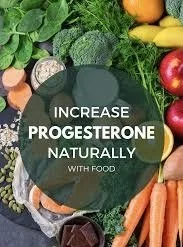How to Make the Anti-Aging Hormone / Fertility Hormone, ‘Progesterone’ - with Diet and Lifestyle.
Boost Progesterone Naturally: The Anti-Aging Hormone Your Diet Can Activate
Progesterone is often referred to as the "anti-aging hormone" due to its critical role in maintaining hormonal balance, promoting skin elasticity, and supporting overall well-being. With declining levels of progesterone as we age, it becomes essential to understand how diet can help stimulate natural production.
Certain nutrients can support your body’s natural progesterone production. Here’s how to enhance your progesterone levels through diet:
🥑 Foods That Support Progesterone Production
1. Magnesium-Rich Foods
Magnesium plays a crucial role in hormone regulation and can support progesterone levels. Foods rich in magnesium include:
• Spinach, kale, and other leafy greens
• Nuts and seeds, such as almonds, pumpkin seeds, and sunflower seeds
• Whole grains like quinoa and brown rice
• Legumes, including black beans and lentils
• Fatty fish like mackerel and salmon
• Dark chocolate
• Avocados
• Bananas
These foods can help regulate hormone levels and aid in progesterone production. All recipe ideas are in my book, Health Empowerment.
2. Zinc-Rich Foods
Zinc is essential for ovulation and progesterone production. Incorporate the following zinc-rich foods into your diet:
• Pumpkin seeds
• Shellfish like oysters
• Chickpeas and lentils
• Nuts like cashews
• Oats
• Mushrooms
Zinc supports the pituitary gland’s release of follicle-stimulating hormone (FSH), which is vital for ovulation and progesterone production.
3. Vitamin B6-Rich Foods
Vitamin B6 is necessary for proper progesterone metabolism. Foods high in vitamin B6 include:
• Sunflower seeds
• Fish
• Dried fruits
Incorporating these foods can help improve progesterone levels.
4. Vitamin C-Rich Foods
Vitamin C may play a role in supporting progesterone levels and reproductive health. Foods high in vitamin C include:
• Citrus fruits like oranges, limes, lemons and grapefruits
• Berries such as strawberries and blueberries
• Kiwi
• Red Bell peppers
• Broccoli
• Camu camu, amla, rosehips and acerola cherry
5. Omega-3 Fatty Acids
Omega-3 fatty acids may support progesterone levels and improve reproductive outcomes. Omega-3-rich foods include:
• Fatty fish like salmon, mackerel, and sardines
• Flaxseeds
• Chia seeds
• Walnuts
• Algal oil (for vegetarians)
These foods help regulate prostaglandins, potentially increasing corpus luteum survival and progesterone production.
6. Cruciferous Vegetables: Vegetables like broccoli, kale, and cauliflower support liver health, which in turn aids in hormone metabolism and balance.
🧘 Lifestyle Tips to Support Hormonal Balance
• Manage Stress: Chronic stress can lead to the “progesterone steal,” where more pregnenolone is used to make cortisol, reducing progesterone levels. Engage in stress-reducing activities like yoga, meditation, and deep breathing exercises.
• Maintain a Healthy Weight: Being overweight or obese can lead to higher oestrogen levels, which may disrupt the balance with progesterone. Aim for a balanced diet and regular physical activity to maintain a healthy weight.
• Ensure Adequate Sleep: Aim for 7-9 hours of uninterrupted sleep per night. Quality sleep supports overall hormonal health and can aid in maintaining progesterone levels.
Gut Health Connection: The health of your gut significantly impacts hormone balance. A diverse and balanced gut microbiome can enhance nutrient absorption and hormone production. To improve gut health:
Include fermented foods such as, kefir, and sauerkraut in your diet.
Increase fibre intake through whole grains, fruits, and vegetables to promote regular digestion.
Stay hydrated to support digestion and nutrient absorption.
See my book, Beauty and the Gut for more on this topic.
🍽 Sample Daily Meal Plan to Support Progesterone
Breakfast: Whole grain rolled, organic oats, topped with sunflower seeds and banana slices
Snack: A handful of almonds and a piece of dark chocolate (no added sugar)
Lunch: Spinach and quinoa salad with grilled salmon and avocado
Snack: Carrot sticks with hummus (see my recipe book, Health Empowerment for hummus recipes)
Dinner: Lentil stew with steamed broccoli and sweet potatoes
This meal plan incorporates foods rich in magnesium, zinc, vitamin B6, and omega-3 fatty acids to support progesterone production.
Conclusion
Activating your body’s natural progesterone production is a holistic process that begins with diet and lifestyle choices. By focusing on nutrient-rich foods and taking care of your gut health, you can support not just hormone balance, but overall well-being as you age. Remember, a healthy gut is the foundation for a healthy life, and with these steps, you’re on your way to boosting progesterone naturally.
If you would like to learn more about how to make progesterone, you can buy my online hormone course - Female Health Empowerment.


